14 Secret Ingredients That Will Take Chocolate Cake To The Next Level
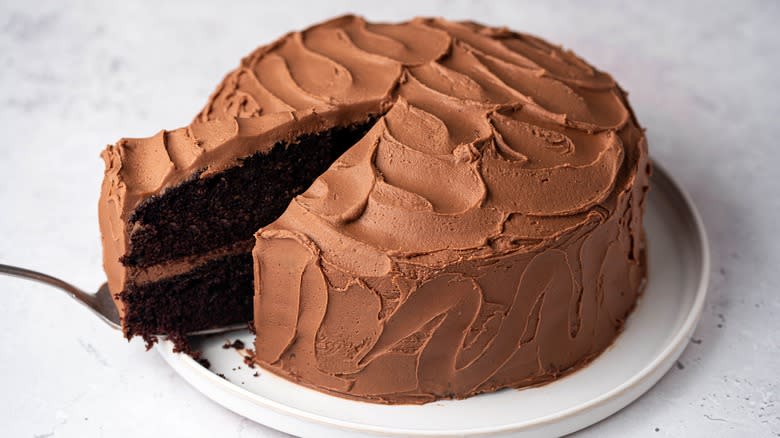
We may receive a commission on purchases made from links.
Is there anything more delicious than a good chocolate cake? We don't think so. Chocolate cake is probably the ultimate dessert, an after-dinner treat beloved by pretty much everyone. Although it feels as though it's been around forever, printed recipes for it didn't start appearing until the middle of the 19th century, with instructions indicating that pieces of whole chocolate were to be mixed into a regular cake batter to give it added richness and flavor. Nowadays, though, the cake gets its chocolatey goodness from the addition of cocoa powder, which not only creates its deep flavor and color but may also have an effect on mood and generate positive feelings, according to a study published in the British Journal of Clinical Pharmacology. No wonder people love it so much!
Virtually anyone can make a chocolate cake, thanks to most recipes requiring little more than self-raising flour, baking powder, eggs, butter, sugar, and — of course — some form of chocolate. However, we wanted to dig a little deeper. As it turns out, there are loads of ways that you can give your chocolate cake a sly boost of flavor, add extra taste dimensions, or improve its texture. Usually, all it takes is a secret ingredient.
Read more: Cake Hacks Every Baker Will Wish They Knew Sooner
Mayonnaise
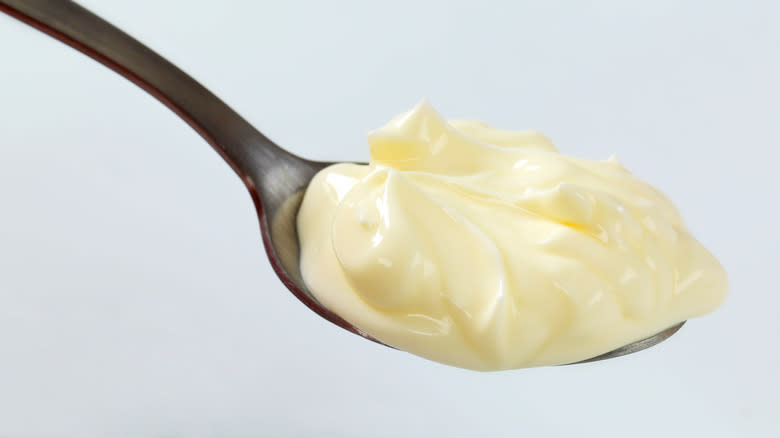
Mayonnaise and chocolate are not a logical pairing on paper. In cake form, however, the combination of the two is sheer heaven. Mayonnaise has shown up in recipes written by mayo manufacturer Hellmann's for chocolate cake since the Great Depression, and it's a favorite amongst vintage-focused food vloggers like B. Dylan Hollis, who tried out a chocolate mayonnaise cake over on TikTok.
As Hollis' reaction shows, using mayonnaise in chocolate cake is more than just a gimmick. Mayonnaise gives your cake added moisture, stopping it from drying out thanks to its high fat levels. Its thickness and creaminess also contribute to the structure of the cake itself, helping to create a tender crumb that's dense without being too fudgy. The slight tang of mayonnaise also helps to play against the sweetness in the cake, stopping it from being one-note and serving as a nice undertone for the chocolate itself. Remember not to just add in mayonnaise at your leisure: It usually serves as a replacement for the eggs and oil, and adding it on top of those ingredients will produce a gloopy cake that doesn't set. Remember, too, not to use light mayo — the point is that you want the fat content.
Coffee
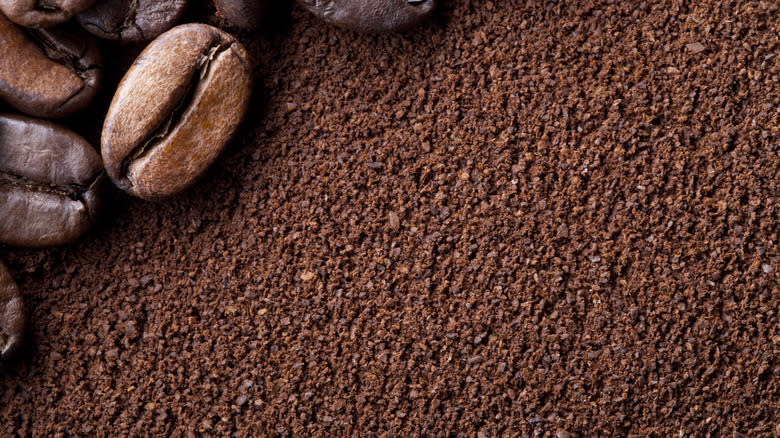
Coffee has long been used as a secret ingredient in dishes like chili, bolognese, and even as a rub for steak. It's not just useful in savory food items, though, and is the perfect addition to chocolate cake. Coffee works wonderfully with chocolate due to its bitterness. Its inherent acrid tone serves to balance out the sweetness of chocolate and chocolate-based desserts, while simultaneously intensifying its flavors.
Coffee can be added to cake in a few different ways. It's perhaps most intense when sprinkled into your dry ingredients as espresso powder. You won't need very much, only a teaspoon or so, to achieve the desired result. You can also add a cup of brewed coffee directly into the cake batter, which will help to add moisture — although keep in mind that you may have to reduce your liquids elsewhere, to stop it from getting too soupy. If you're adding coffee powder, ensure that it's as finely ground as possible, or you'll find yourself biting into gritty pieces of coffee bean as you munch your cake. You should also keep in mind that using coffee might not be suitable for everyone, especially those who are caffeine-sensitive or children.
British Rich Tea Biscuits
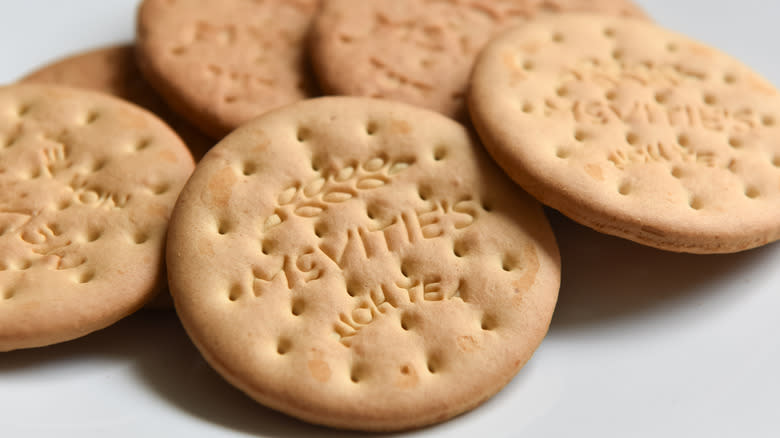
Chocolate cake is typically dense, moist, and soft, but a little textural contrast goes a long way. It's achieved by adding in a potentially surprising ingredient: British rich tea biscuits. This was a favorite variation of none other than the late Queen Elizabeth herself, who apparently liked it so much that she had a slice every day. "The royal chefs send a whole cake up to Her Majesty every day for tea. She will sometimes take a slice and then it is never seen at the royal table again," explained her former chef Darren McGrady, via Hello! Magazine.
British rich tea biscuits are an excellent cake ingredient as they're dry and lightly sweet, which means that they neither distract from the cake nor soften too much in the batter, providing a satisfying crunch in every bite. They also have a slight maltiness to their taste which adds an extra layer of flavor. To make the royal cake, the biscuits are broken up by hand until each piece is about the size of an almond, and the chunks are then folded gently into a chocolate batter which is refrigerated to firm up before being baked.
Sauerkraut
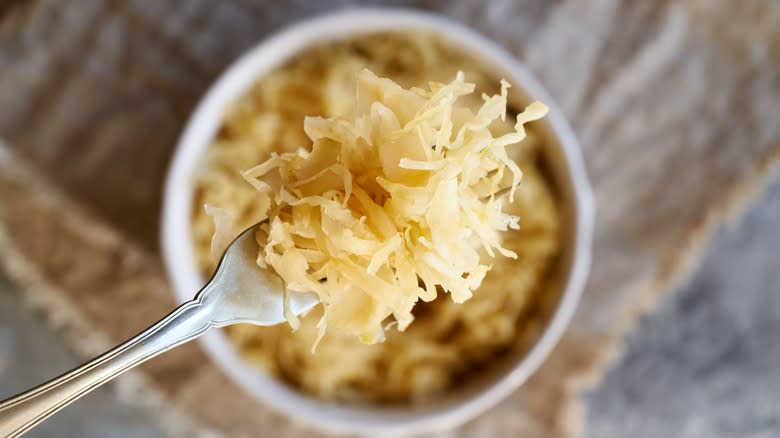
Although adding sauerkraut to chocolate cake might sound like the worst idea ever, don't knock it till you've tried it. Sauerkraut-infused chocolate cake has been spoken about, sometimes in horrified tones, ever since it burst onto the scene in a recipe published by the San Bernadino Sun in 1965. The recipe states that drained sauerkraut, when mixed into a chocolate cake batter, provides extra moisture and a little extra texture, and doesn't alter its flavor too much as long as it's been washed beforehand.
While this all might sound a little bizarre, there's a lot of logic to it. Sauerkraut, made from fermented cabbage, does retain its moisture excellently, ensuring that it doesn't seep out of the cake when it's baked. Additionally, the tangy, funky flavor of sauerkraut serves as a natural leveler for sweetness and gives your cake a way more complex, exciting flavor. As for the cabbage element, is the idea of using sauerkraut so strange? As Sandor Katz, author of "Wild Fermentation," noted to Atlas Obscura, "The idea of using vegetables in a cake to moisten it, to make it more nourishing, that's not exactly alien. We already had carrot cakes, we had zucchini cakes," The acidic nature of sauerkraut means that it may also give a useful boost as a rising agent when combined with an alkaline substance like baking soda.
Root Beer
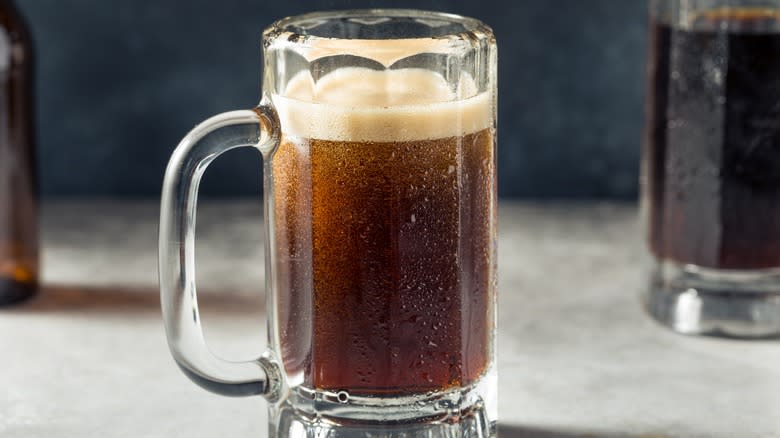
As beverages go, root beer has more of a relationship with desserts than most. This drink is good for more than just root beer floats, though. Its sweet, woody, slightly spicy flavor can also help give a delicious twist to chocolate cake. Root beer has a complexity and maltiness that works terrifically with chocolate, and serves to make the cake more interesting and dynamic. When combined with other spices, like cinnamon, star anise, and nutmeg, it helps to make an intense-tasting and unique dessert. The beer's sweetness, meanwhile, stops it from becoming overpowering and tasting too savory or muddy.
Root beer's carbonation also affects the cake's crumb. Because the drink is full of gas, it can help to lighten the cake somewhat, creating aeration in the batter. Bear in mind that the added root beer will make the whole cake a bit more delicate, so it can be slightly harder to remove from your pan, easily tearing apart upon exit. It's most at risk of doing this if you're using a pan that's particularly detailed or has small rivets or sections where the cake can get stuck, so try and use a flat dish if possible.
Vinegar

The thought of adding vinegar to a sweet, delicious chocolate cake might fill you with fear, but trust us on this one. Vinegar adds an acidity that can help to intensify the flavor of your chocolate and sugar. Its main use, though, is for the cake's structure. It's especially useful, and important, in eggless cakes that use baking soda to help them rise. The baking soda needs something acidic to respond to, to give the cake some much-needed aeration — and while things like yogurt or buttermilk can do the trick, sometimes your cake needs an extra boost.
Vinegar, therefore, makes the baking soda react strongly, allowing the cake to rise and giving it buoyancy and lightness. You only need a small amount of vinegar to do this, and using too much will distract from the flavor of your cake. You should also remember to use the most neutral-tasting vinegar possible. Using something like balsamic or red wine vinegar, for example, will fill your cake with unpleasant extra flavors that make it taste strange. Go for white wine, distilled white, or cider vinegar.
Mashed Potatoes
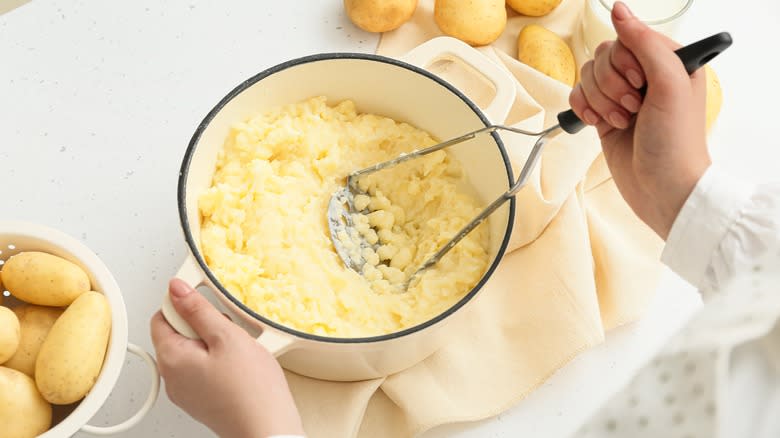
Chocolate and mashed potatoes may sound like a funny combination, but it's not as strange as you think. Chocolate potato cake recipes have been around since the start of the 20th century, with one appearing in the classic cookbook "A New Book of Cookery" by Fannie Merritt Farmer. In the cookbook, Farmer instructs that you combine riced potatoes with flour, butter, milk, eggs, sugar, and grated chocolate, before baking it and covering it with a fudgey chocolate frosting.
The result is an ultra-moist cake, with a tender crumb and a mild yet rich flavor. Potatoes, like flour, have starch in them, and this starch helps to hold the cake together while keeping it soft and delightfully chewy. You can, of course, substitute the grated chocolate for cocoa powder, to achieve a deeper chocolate flavor and a dark-brown color throughout. If you go with grated chocolate, however, you'll find that your crumb is lighter, and almost looks like a banana bread or a wheat flour loaf. Mashed potato is also a great choice for gluten-free cakes, as it performs much of the function that regular flour does. If you opt for this, try combining it with a small amount of rice flour and some ground almonds.
Sour Cream
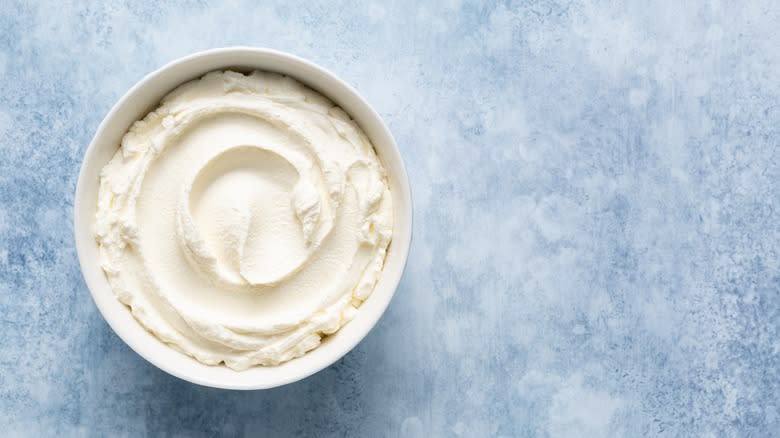
Sweet and sour is a well-established combination, but it's rarely found in chocolate cake. We're here to argue, though, that it should be, and sour cream is the perfect way to achieve it. Sour cream alters both the flavor and the consistency of chocolate cake, improving both. As explained by the author of "The Joys of Baking: Recipes and Stories for a Sweet Life," Samantha Seneviratne, "It adds a subtle tang to the flavor of baked goods. The fat contributes to moistness and richness that makes tender cakes" (via Martha Stewart).
The sour taste is, of course, added by the acidic nature of sour cream, which helps cut through any excessive richness the chocolate may deliver. Its fat goes to work on the texture, meanwhile, by shortening the gluten strands in the cake, stopping it from becoming tough. If using sour cream, it's a good idea to substitute it in place of milk or another liquid component, as putting it in as an extra may make your cake too sloppy and stop it from setting properly in the oven. Sour cream can also be substituted with full-fat yogurt or creme fraiche, both of which will give a similar flavor and deliver the necessary fats to the batter.
Beets
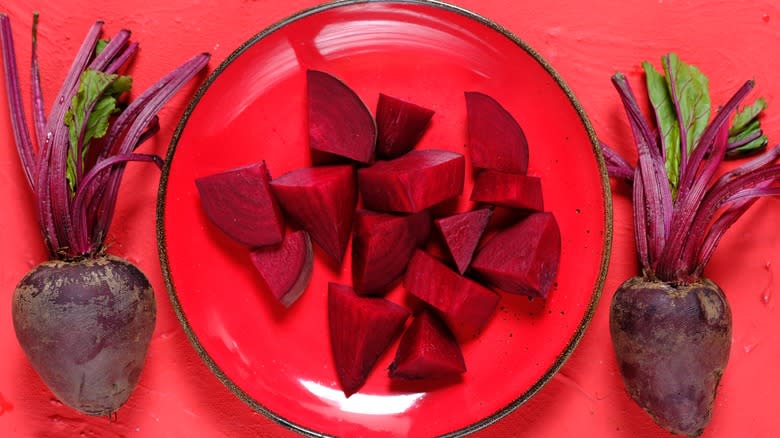
Putting vegetables in cake is by no means a new thing, but using beets may still be a surprising suggestion. Don't knock it til you've tried it, though. Beets imbue your chocolate cake with a deep, rich, dark red color, making everything look so much more luxurious and tasty. As well as aesthetics, the beet's slight earthiness pairs with the cocoa in your cake to produce a serious intensity, while the sweet notes in beets are highlighted by the sugar.
Beets also contribute to the chocolate cake's texture, helping to slightly tenderize the crumb. To use beets in your cake, you don't even have to cook them first. Grate your raw beets directly into your batter, mixing them through thoroughly. The small pieces will cook as your cake sets. You can also cook them beforehand, by roasting the beets in the oven, which will give your cake a potentially softer crumb throughout. If you want to go all-out, retain a little bit of beet juice and pour some into your frosting, which will tint it a vibrant shade of pink.
Applesauce
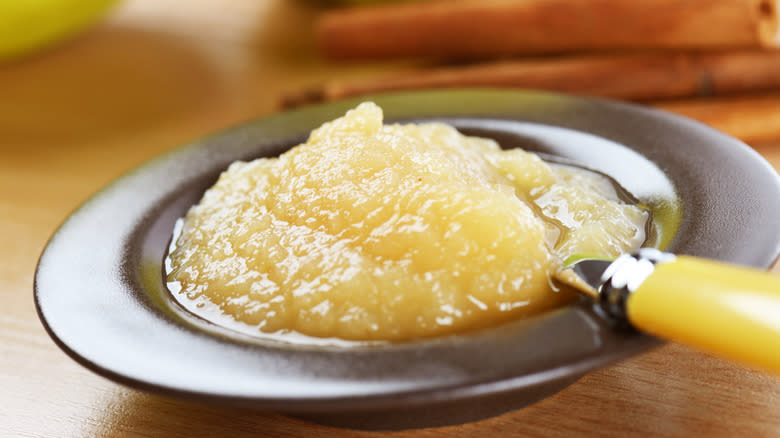
For people who are trying to cut down on fat, baking a chocolate cake is rarely the answer. Unless, that is, they make it with applesauce. Applesauce is a magnificent substitute for oil or butter thanks to its relatively high water content, which adds moisture to your chocolate cake. It can be swapped in at a 1:1 ratio, and doing so can reduce the calorie and fat content of your cake significantly.
Applesauce can also bring a serious sweetness to chocolate cake, and give its flavor a subtle note of apple, creating some extra layers. Using applesauce, however, comes with a few caveats. Adding it will alter the texture of your cake, potentially making it tougher, so it might be worth still including some fat to balance things out. Opting to use half of your original fat and replacing half of it with applesauce can be a good middle ground, for example. You may also find that applesauce makes your cake too sweet, particularly if you don't adjust your sugar ratio accordingly. To avoid this, it's best to use unsweetened applesauce or cut down on your added sugar.
Beer
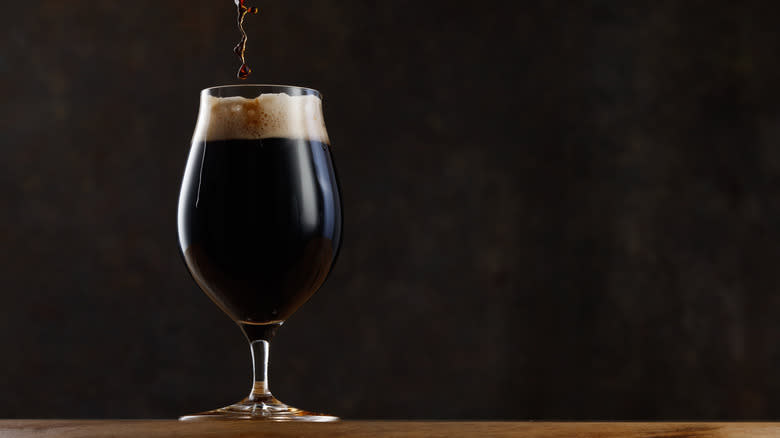
When it comes to chocolate cake, a little alcohol is a good thing, and beer is one of the best types you can add. Ales in particular, especially darker ones like stout, can deliver a real richness and complexity. Stouts have a malty, bitter flavor, often with notes of chocolate, making them a natural partner to cocoa and chocolate chips. Stout also gives your chocolate cake a really deep color and assists in keeping the cake moist.
Porter, another style of dark beer, can also be used in chocolate cake. Bear in mind that porter will add more maltiness to your recipe, as it's made with malted barley. When using beer, the majority of alcohol in the cake will evaporate as it cooks, so you don't need to worry about making your guests drunk inadvertently. You can use lighter types of beer in chocolate cake, too, with lager giving your cake a slightly more caramelized flavor. It's best to avoid beers that are especially strongly flavored, though; some IPAs, for example, have fruity or sour notes that will completely distract from the chocolate itself.
Baby Food
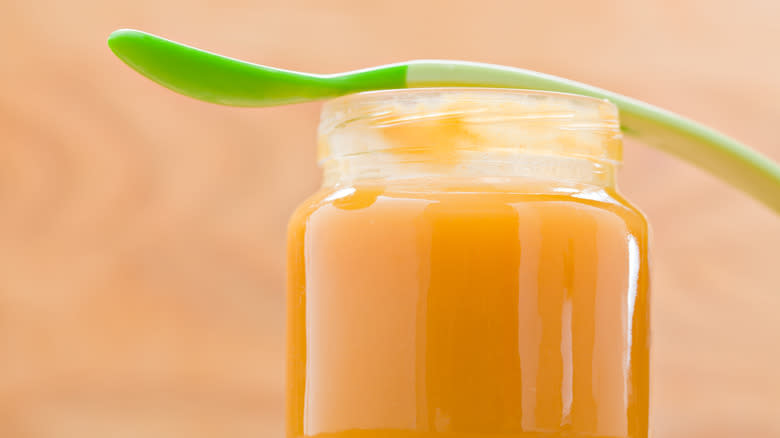
Okay, just trust us on this one. It might not be your go-to for a cake recipe, but baby food works surprisingly well in your chocolate dessert. This addition works similarly to applesauce and can add moisture and flavor to a cake, particularly in place of fat. Baby food is also a great substitute for eggs in chocolate cake recipes.
While you can, in theory, use any type of baby food in a chocolate cake, we would recommend going for prune flavor. Prunes have a mellow, deep taste that can be reminiscent of chocolate, and a subtle, natural sweetness. Prune-flavored baby food, and other types of baby food, are essentially puréed fruits or vegetables and usually don't have any added salt or sugar, making them a great way to sneak some additional vitamins and minerals into your cake. If you're using baby food as a substitute for other ingredients, use a 1:1 ratio for liquid fats like oil or butter, or two tablespoons of baby food per egg. Otherwise, you can simply stir a few tablespoons into your existing cake batter, and enjoy the flavor boost it gives your dessert.
Pumpkin
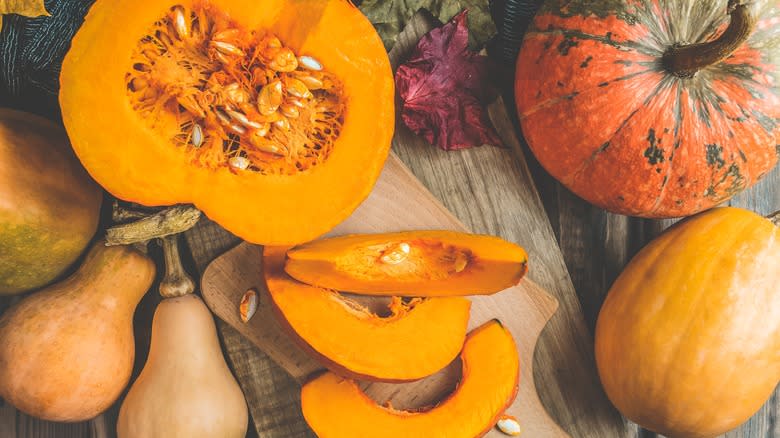
If you have any leftover pumpkin lying around, throwing it out is never the answer. Instead, incorporate it into your next chocolate cake. Pumpkin is a fabulous addition to chocolate cake, thanks to its sweet, lightly nutty taste and inherent moisture. When added to a cake batter, it gives a delicious density thanks to its fiber-rich composition and helps to keep your cake tender, preventing it from drying out.
You'll likely want to avoid throwing in whole chunks of pumpkin into your batter, and instead add it in puréed form. This can be as simple as pouring some puréed pumpkin from a can into your batter, or blending some roasted pumpkin pieces until they're a fine paste. Crucially, too, you don't have to just use pumpkin. Virtually any squash can be added to chocolate cake, from butternut to kuri squash, and they'll all have a similar effect and provide specific flavor notes. Different squash types will also give your chocolate cake slightly different colors; while pumpkin will give the batter an orange tone, using something like zucchini can give it a paler appearance.
Avocado
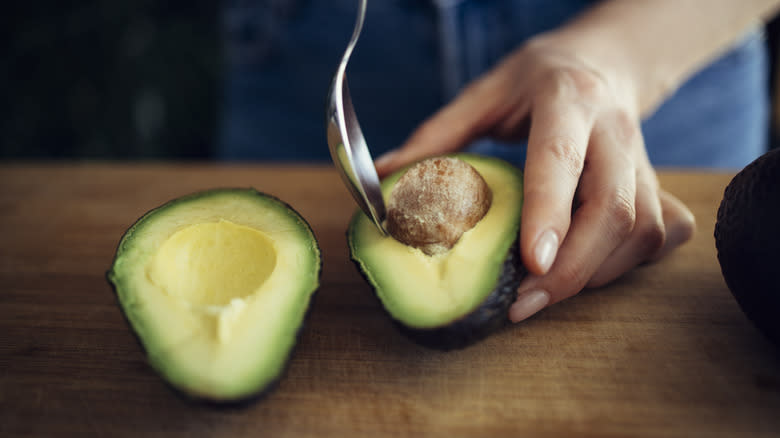
Got some avocados that are about to go bad? Throw them into your chocolate cake. Avocado is the perfect addition to chocolate cake for folks who are following a vegan diet, or simply looking to avoid butter or eggs. This vegetable is super high in fat, giving your chocolate cake the richness that these animal-based products would normally provide. Additionally, it has a creamy, slightly buttery flavor that won't distract at all from anything else in the cake, and will instead help to mellow out the slightly bitter cocoa. To top it all off, adding avocados to your cake will also fill it with additional nutrients like potassium, magnesium, and vitamins C, E, K, and B5, as well as healthy monounsaturated fats.
You'll have to mash your avocado down until it's a smooth paste, so make sure you're using one that's as ripe as possible. If it's unripe, it will remain tough, and even if you do manage to break it down, it'll be chalky and stringy. Make sure to avoid using any avocados that have discoloration, as they run the risk of making your cake taste rancid.
Read the original article on Daily Meal.

